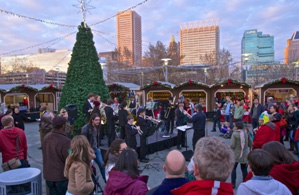
Mulled wine, also known as spiced wine, is an alcoholic drink usually made with red wine, along with various mulling spices and sometimes raisins, served hot or warm. It is a traditional drink during winter, especially around Christmas. It is usually served at Christmas markets in Europe, primarily in Germany, Czech Republic, Austria, Switzerland, Slovenia, Croatia, Romania, Nordics, Baltics and eastern France. There are non-alcoholic versions of it. Vodka-spiked mulled wine can be found in Polish Christmas markets, where mulled wine is commonly used as a mixer.
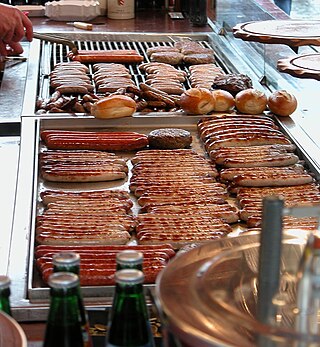
Bratwurst is a type of German sausage made from pork or, less commonly, beef or veal. The name is derived from the Old High German Brätwurst, from brät-, finely chopped meat, and Wurst, sausage, although in modern German it is often associated with the verb braten, to pan fry or roast. Beef and veal are usually incorporated amongst a blend often including pork. Beef or veal is usual in halal and kosher Bratwurst sausages, which never include pork for religious reasons.

Lebkuchen, Honigkuchen or Pfefferkuchen are honey-sweetened German cakes, moulded cookies or bar cookies that have become part of Germany's Christmas traditions. They are similar to gingerbread.

The Striezelmarkt in Dresden is one of the first genuine Christmas markets in the world. Founded as a one-day market in 1434, it celebrated its 585th anniversary in 2019. Its 240 stands attract about 3 million visitors from all over the world. The annual market lasts throughout the Advent season until Christmas Eve.

Buxtehude, officially the Hanseatic City of Buxtehude, is a town on the Este River in Northern Germany, belonging to the district of Stade in Lower Saxony. It is part of the Hamburg Metropolitan Region and attached to the city's S-Bahn rapid transit network. Buxtehude is a medium-sized town and the second largest municipality in the Stade district. It lies on the southern border of the Altes Land in close proximity to the city-state of Hamburg. To the west lie the towns of Horneburg and Stade and to the south there are a number of incorporated villages featuring mostly upscale housing; e.g., Ottensen and Apensen.

A gingerbread house is a novelty confectionery shaped like a building that is made of cookie dough, cut and baked into appropriate components like walls and roofing. The usual base material is crisp gingerbread, hence the name. Another type of model-making with gingerbread uses a boiled dough that can be moulded like clay to form edible statuettes or other decorations. These houses, covered with a variety of candies and icing, are popular Christmas decorations.

The observance of Christmas around the world varies by country. The day of Christmas, and in some cases the day before and the day after, are recognized by many national governments and cultures worldwide, including in areas where Christianity is a minority religion. In some non-Christian areas, periods of former colonial rule introduced the celebration ; in others, Christian minorities or foreign cultural influences have led populations to observe the holiday.

A Christmas market is a street market associated with the celebration of Christmas during the four weeks of Advent. These markets originated in Germany, but are now held in many countries. Some in the U.S. have adapted the name to the quasi-German Christkindlmarket, substituting market for German Markt.

A marketplace, market place or just market is a location where people regularly gather for the purchase and sale of provisions, livestock, and other goods. In different parts of the world, a marketplace may be described as a souk, bazaar, a fixed mercado (Spanish), or itinerant tianguis (Mexico), or palengke (Philippines). Some markets operate daily and are said to be permanent markets while others are held once a week or on less frequent specified days such as festival days and are said to be periodic markets. The form that a market adopts depends on its locality's population, culture, ambient and geographic conditions. The term market covers many types of trading, as market squares, market halls and food halls, and their different varieties. Thus marketplaces can be both outdoors and indoors, and in the modern world, online marketplaces.

Weihnachten is the observance of what is commonly known in English as Christmas in the German-speaking countries such as Germany, Austria and Switzerland. It is also widespread in countries with a German-speaking minority, such as Transylvania in Romania, South Tyrol in Italy, Eupen in Belgium, and various diasporas such as the German Brazilian and German American communities. Traditions of Weihnachten influenced Advent and Christmastide culture throughout the world.

Christkindlmarket is a Christmas market held annually at Daley Plaza in Chicago, Illinois, United States. The festival attracts more than 1 million visitors each year.

Christkindlesmarkt is a Christmas market that is held annually in Nuremberg, Germany. It takes place during Advent in the Hauptmarkt, the central square in Nuremberg’s old town, and in adjoining squares and streets. With about two million visitors a year the Nürnberger Christkindlesmarkt is one of the largest Christmas markets in Germany and one of the most famous in the world. Every year the Christmas market begins on the Friday preceding the first Sunday in Advent and ends on 24 December unless that day is a Sunday.

Mahane Yehuda Market, often referred to as "The Shuk", is a marketplace in Jerusalem. Popular with locals and tourists alike, the market's more than 250 vendors sell fresh fruits and vegetables; baked goods; fish, meat and cheeses; nuts, seeds, and spices; wines and liquors; clothing and shoes; and housewares, textiles, and Judaica.

The Eugene Saturday Market is an outdoor craft market in Eugene, Oregon. It is the oldest weekly open-air crafts market in the United States. It has a festival atmosphere that includes live performers as well as art and crafts displays and sales, and also food booths and other local vendors. Between 3,000 and 5,000 people visit the market every Saturday.

The Christmas Village in Philadelphia is an annual outdoor Christmas market event in LOVE Park, at which vendors in wooden booths and a vendor tent sell international seasonal holiday gifts, ornaments, arts, and crafts, as well as European food, sweets, and hot beverages.
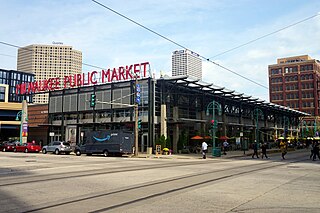
Milwaukee Public Market is a public market located in the Historic Third Ward neighborhood in Milwaukee, Wisconsin. Space in the building is leased to vendors, primarily local food businesses.
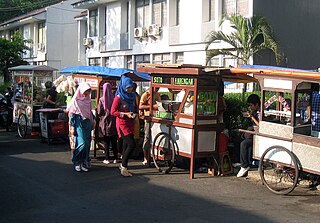
Indonesian street food is a collection of ready-to-eat meals, snacks, fruits and drinks sold by hawkers or vendors at warung food stalls or food carts. Street food in Indonesia is a diverse mix of local Indonesian, Chinese, and Dutch influences. Indonesian street food are usually cheap, offer a great variety of food of different tastes, and can be found on every corner of the city.

The Dortmund Christmas Market is an annual outdoor Christmas market held every year in central Dortmund, North Rhine-Westphalia, Germany. With more than three and a half million visitors of 300 stalls, it is one of the biggest Christmas markets of the world and brings tourists from all over the world to Dortmund. It is estimated that the city benefits of a 100 million Euros profit from this 38-day-long tradition.
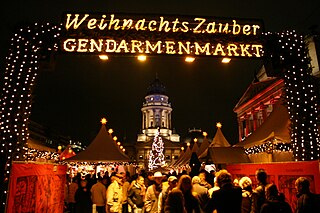
There are over 80 Christmas markets in various parts of Berlin, where craftspeople demonstrate their skills and sell their wares along with many other Christmas gifts and fairground attractions. The first Christmas market took place in 1530 in Alt-Berlin.
